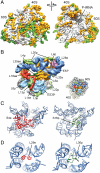Localization of eukaryote-specific ribosomal proteins in a 5.5-Å cryo-EM map of the 80S eukaryotic ribosome
- PMID: 20974910
- PMCID: PMC2993421
- DOI: 10.1073/pnas.1010005107
Localization of eukaryote-specific ribosomal proteins in a 5.5-Å cryo-EM map of the 80S eukaryotic ribosome
Abstract
Protein synthesis in all living organisms occurs on ribonucleoprotein particles, called ribosomes. Despite the universality of this process, eukaryotic ribosomes are significantly larger in size than their bacterial counterparts due in part to the presence of 80 r proteins rather than 54 in bacteria. Using cryoelectron microscopy reconstructions of a translating plant (Triticum aestivum) 80S ribosome at 5.5-Å resolution, together with a 6.1-Å map of a translating Saccharomyces cerevisiae 80S ribosome, we have localized and modeled 74/80 (92.5%) of the ribosomal proteins, encompassing 12 archaeal/eukaryote-specific small subunit proteins as well as the complete complement of the ribosomal proteins of the eukaryotic large subunit. Near-complete atomic models of the 80S ribosome provide insights into the structure, function, and evolution of the eukaryotic translational apparatus.
Conflict of interest statement
The authors declare no conflict of interest.
Figures





Similar articles
-
Cryo-EM structure and rRNA model of a translating eukaryotic 80S ribosome at 5.5-A resolution.Proc Natl Acad Sci U S A. 2010 Nov 16;107(46):19748-53. doi: 10.1073/pnas.1009999107. Epub 2010 Oct 27. Proc Natl Acad Sci U S A. 2010. PMID: 20980660 Free PMC article.
-
The structure and function of the eukaryotic ribosome.Cold Spring Harb Perspect Biol. 2012 May 1;4(5):a011536. doi: 10.1101/cshperspect.a011536. Cold Spring Harb Perspect Biol. 2012. PMID: 22550233 Free PMC article. Review.
-
Structures of the human and Drosophila 80S ribosome.Nature. 2013 May 2;497(7447):80-5. doi: 10.1038/nature12104. Nature. 2013. PMID: 23636399
-
Eukaryotic Ribosome Assembly.Annu Rev Biochem. 2024 Aug;93(1):189-210. doi: 10.1146/annurev-biochem-030222-113611. Epub 2024 Jul 2. Annu Rev Biochem. 2024. PMID: 38768392 Review.
-
Structure of the human 80S ribosome.Nature. 2015 Apr 30;520(7549):640-5. doi: 10.1038/nature14427. Epub 2015 Apr 22. Nature. 2015. PMID: 25901680
Cited by
-
High resolution RNA-seq profiling of genes encoding ribosomal proteins across different organs and developmental stages in Arabidopsis thaliana.Plant Direct. 2021 May 27;5(5):e00320. doi: 10.1002/pld3.320. eCollection 2021 May. Plant Direct. 2021. PMID: 34095740 Free PMC article.
-
Ribosome-mediated specificity in Hox mRNA translation and vertebrate tissue patterning.Cell. 2011 Apr 29;145(3):383-397. doi: 10.1016/j.cell.2011.03.028. Cell. 2011. PMID: 21529712 Free PMC article.
-
HIV-1 nuclear import is selective and depends on both capsid elasticity and nuclear pore adaptability.Nat Microbiol. 2025 Aug;10(8):1868-1885. doi: 10.1038/s41564-025-02054-z. Epub 2025 Jul 7. Nat Microbiol. 2025. PMID: 40624219 Free PMC article.
-
Ribosomal Protein Rps26 Influences 80S Ribosome Assembly in Saccharomyces cerevisiae.mSphere. 2016 Feb 24;1(1):e00109-15. doi: 10.1128/mSphere.00109-15. eCollection 2016 Jan-Feb. mSphere. 2016. PMID: 27303706 Free PMC article.
-
The DARC site: a database of aligned ribosomal complexes.Nucleic Acids Res. 2012 Jan;40(Database issue):D495-500. doi: 10.1093/nar/gkr824. Epub 2011 Oct 18. Nucleic Acids Res. 2012. PMID: 22009674 Free PMC article.
References
-
- Schmeing TM, Ramakrishnan V. What recent ribosome structures have revealed about the mechanism of translation. Nature. 2009;461:1234–1242. - PubMed
Publication types
MeSH terms
Substances
Associated data
- Actions
- Actions
- Actions
- Actions
- Actions
- Actions
- Actions
- Actions
- Actions
LinkOut - more resources
Full Text Sources
Other Literature Sources
Molecular Biology Databases

